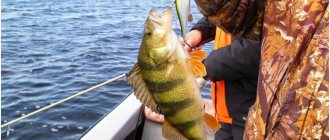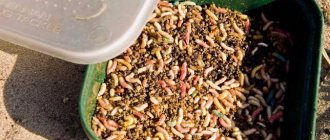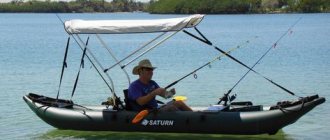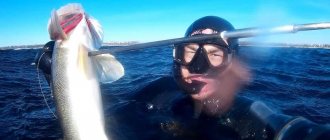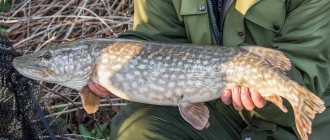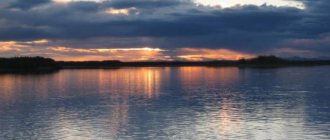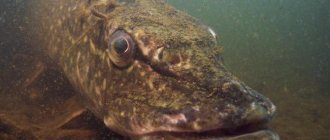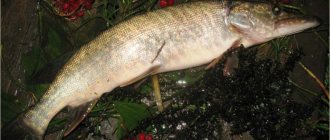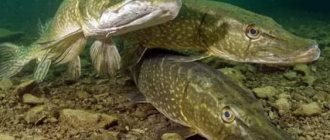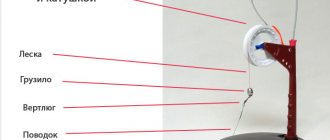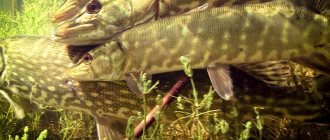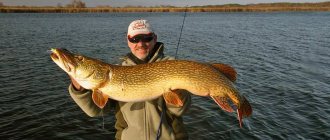When choosing a place to go for “long-distance” fishing, many fishermen
turn their attention to the Lower Volga basin - the area from Volgograd to Astrakhan, and this is not accidental. The unique nature and climate of these places make them very attractive for fishing, recreation and travel, and the presence of a fairly developed transport infrastructure makes it relatively easy to reach the most remote and remote corners of the Volga expanses.
Fishing in the Lower Volga, including Akhtuba, will truly not leave either a professional or an amateur beginner indifferent. More than 60 species of river and semi-anadromous (entering the channel from the Caspian Sea) fish inhabit the rivers Akhtuba, Mangut, Kharabalyk, Ashuluk and many adjacent ilmens, eriks and oxbow lakes. Many species of fish have great commercial value. The rich food supply allows local river inhabitants to reproduce and grow to very impressive sizes. Catfish, pike, pike perch and carp of record, trophy sizes are often caught here. One of the most popular and exciting ways of catching predatory fish in the Lower Volga reservoirs is spinning with artificial baits, as well as fishing with jig baits. If you're about to try your luck with spinning in these parts for the first time, but don't know where to start, this information may come in handy. So where to start?
Choosing a place for fishing: Three Rivers on Akhtuba?
This place, characteristic of the Lower Volga in its relief and position, is located
between Volgograd and Astrakhan, or rather, 30 km south of the city of Kharabali and is an island with an area of about 40 square meters. km, formed by the Akhtuba channel and its two branches - Mangut and Kharabalyk. The choice of Trekhrechye for predator fishing, in this case pike, is due to the fact that all types of reservoirs are concentrated here in a relatively small area of the Volga-Akhtuba floodplain, all types of bottom and shore topography are found, including abundant aquatic vegetation, and channel pits in Trekhrechye can reach 20-28 meters in depth. Thus, the uniqueness of Trekhrechye is that the entire period of open water, with the exception of high water when water is discharged from the Volgograd hydroelectric station, here you can catch predatory and peaceful fish in many ways, both from a boat and from the shore. In almost any season, time of day and weather, there is an opportunity to successfully hunt for one or two species of fish. For example, the sun hid behind a dense gloom, a nasty wind blew, raising ripples on the water, and a lingering light rain began to drizzle, which, however, is rare in Three Rivers. In this weather, the pike perch completely refuses to bite. No problem! This kind of drizzle with ripples on the surface is the best conditions for catching large pike all day long. In addition, if you are completely unfamiliar with the area and the behavioral characteristics of the local predator, you can always ask for advice or use the services of an experienced huntsman - an employee of the local fishing base. And then you definitely won’t be left without fish.
Base of fishermen and hunters "White Beach"
Coordinates and purpose:
- Tsagan-Aman village, Yustinsky district;
- Lower Volga;
- Purpose: in winter and summer (permitted period) hunting - including underwater and fishing;
- Additional relaxation: solitude with nature, lotus blossoms and excursions to local attractions.
Beach
Why are there so many pike here?
In fact, the entire Volga basin up to the city of Volgograd is a cascade of reservoirs. Therefore, the entire hydrological regime of the Lower Volga is mostly connected with the regime
water discharges through the sluices of the Volgograd hydroelectric power station, and not with natural phenomena, except for the spring flood. But even here, the presence of water regulation led to a change in the entire ecosystem - at the moment of ice melting, huge quantities of ice water from the bottom of the Volgograd Reservoir are discharged into the lower reaches of the Volga to flush the tailwater in front of the dam. As a result, in the channels and branches of the Volga-Akhtuba floodplain and in Trekhrechye in particular, the water temperature rises with a delay. This situation leads to the fact that the pike spawns and grows later than necessary, so that its young quickly reach the required size and can immediately feed on the hatched fry of peaceful fish. But the pike adapted here too. And it actively reproduces in the lower reaches. And the presence of a huge number of fry, including due to blocked routes to the upper reaches of the Volga (river and semi-anadromous Caspian fish have to spawn before the Volgograd hydroelectric power station), provides juvenile pike with a rich food supply. At the same time, the topography of the riverbeds, the flooded snags and trees, and the diversity of local aquatic ecosystems allow the “thunderstorm of crucians” to fatten in the Lower Volga to incredible sizes. In Trekhrechye, for example, guests of the fishing base of the same name often catch “crocodiles” weighing up to 10-15 kg. Large pike prefers to hunt from
She really likes ambushes and the presence of a large number of shelters in the local bodies of water. The main catch of large pike in Three Rivers: roach, bleak, rudd, ruffe, juvenile crucian carp, carp and buffalo, perch, and silver bream. There are an insane amount of this peaceful and not very small fish here. Moreover, as they grow, young pike move from shallow waters in eriks and backwaters, where they fed on fry, to larger areas in the riverbeds of Akhtuba, Mangut and Kharabalyk and hunt quite decent specimens, which “are not a shame to put in a cage.” Often, carp and bream weighing up to a kilogram with obvious fresh marks of pike teeth on the back and sides are caught on a donkey or fishing rod - this is the characteristic grip of a predator across the body of the prey. Pike in the Lower Volga has few competitors in the food pyramid. Pike perch, asp and catfish, feeding on the same prey, hunt mainly in other areas, depths and at other times of the year and day. Large solitary pike perch, which leads a lifestyle similar to pike, is not so numerous and also prefers prey different from pike, since pike perch has a relatively small mouth and, with the same weight and size as pike, it is not able to swallow a “pike” lunch. Pike perch feeds more on fry and small fish with an elongated body: bleak, roach, gudgeon.
Jig is a tackle for spot fishing, so you need to constantly look for a predator
If this is your first time on a pond and you don’t have a clear idea of where to look for large pike at the moment, it will take some effort to find fish. Knowledge of the behavioral characteristics of a local predator and personal experience, as well as any
Information from local anglers will be the key to successful fishing and increase your chances of catching a serious trophy. The mooring sites for pike are varied and gravitate towards various underwater obstacles and anomalies: - the concentration points of large pike in the channels are tied to the current, the optimal place would be where the boundary of the streams passes or there is a lateral current from shallow water to depth; — areas of flooded snags with an almost flat bottom, flooded trees; — underwater edges and submerged islands (elevations on the bottom); — deep channel holes, deep-sea trenches; - breaker jets in front of the islands. In autumn, closer to winter, large pike are often found on coastal slopes, especially if the bottom topography is broken and descends into the depths in steps. Most likely, schools of bream and silver bream approach the shore here in late autumn, followed by a large predator. If the reservoir is familiar to you and you have already fished with jigs, then there are certain “catching” points. However, never give up exploring new places and checking information from fellow fishermen. The fact is that the more promising areas you know, the greater the chances of success in fishing, since not all areas work at different times of the day and year. In addition, large pike lead a relatively sedentary lifestyle and, having found a convenient parking lot, do not leave it as long as there is prey. After the owner of such a hunting area is captured, it may take some time until the next comrade settles here.
Choosing bait and equipment for catching large pike
Jig tackle is used for catching pike at any time of the year, throughout the entire period of open water, but jig fishing is most effective in early spring and autumn, when the large predator moves to the depths. The classic soft bait for jig fishing for pike on the Lower Volga is a large twister with a wide tail. The color can be varied, it doesn’t matter much, especially when fishing from depth and in muddy water. If the depth is shallow, the water is quite clear, most often local pike prefer twisters of white, light green and yellow colors, as well as contrasting combinations, for example, red head (white with a red head), black and yellow, blue and white. As a variant of jig bait, foam fish are also used, which pike and pike perch readily peck from the bottom in spring and autumn. From experience, the color of the body of the foam rubber does not matter at all. Soft baits attract pike primarily by their unique vibrations, reminiscent of a weakened fish that moves with difficulty. The weights of the jig heads, be it a classic hook soldered into a lead weight or a Cheburashka, hinged with an offset hook, or even a bullet on a steel leash such as a Carolina rig, must be heavy enough to “pierce” a sufficient thickness of water in case of fishing on the riverbed under strong conditions. flow. In Trekhrechye, when fishing on riverbeds, the weight of jig heads is selected depending on the situation from 20 to 45 grams. The spinning test is selected accordingly, of which it is good to have several: up to 25, up to 40 and up to 60 gr. The size of the softest bait (twister or vibrotail) does not play a special role - a large pike will gladly attack any bait that finds itself in the zone
throwing reach. Considering that even a small pike can easily swallow 200-350 grams of roach. weight, you shouldn’t limit the size of the twisters, but there is one “but” - a large bait with a lot of resistance to the flow will pull the sinker and behave “wrongly,” sometimes not reaching the bottom at all. Therefore, it is worth empirically choosing the ratio of the sizes of the twister and the jig head, and you can shorten the body of the twister without losing the quality of the game if you are catching large fish in shallow water. When fishing for pike, a leash is an integral part of all jig equipment, since our toothy beauty has razor-sharp edges of its gill scutes. With some luck, the pike can easily cut both monofilament and braided line in one movement. At one time, fishermen often used thin piano wire, but it had a serious drawback - after fighting with a trophy fish, it curled into a spiral. Pike leashes made of thin cord wire have proven themselves to be quite good, but their disadvantage is excessive rigidity. Fluorocarbon of large cross-section (0.4-0.5 mm) is also used as a leader material. Leashes made of multifilament thin tungsten wire are very popular - this is perhaps the most suitable material for catching pike with a jig in the current.
Some features of catching pike with jigs in Trekhrechye
There are no difficulties with step-by-step wiring of heavy jig heads and Cheburashkas (and they will be quite heavy due to the current and depths). Even a beginner can master this fishing technique.
There is an interesting point in catching large pike in these parts. Pike, which prefers hunting from ambush, usually does not pursue its prey, but having attacked once at a length of 1-2 body lengths and missed, it loses interest in it. But in Three Rivers it often happens that a large predator begins to chase the bait and attacks it again. This behavior of pike is typical when fishing with soft baits (silicone, foam rubber), which, at the first unsuccessful grip, do not leave the predator with suspicion of deception, unlike metal spinners and wobblers. And unhurried retrieval of the jig bait with pauses predisposes the pike to a new attack. So after the first miss of a predator, be it a pike perch or a pike, do not stop retrieving - repeated bites are possible. If the strikes on the bait are sluggish and disappear one after another, you should try changing the bait or the pace of the retrieve, making longer pauses between steps, and changing the amplitude (height) of the steps.
By-catch with this method of fishing in the fall and spring in the cage includes pike perch and asp, and sometimes medium-sized catfish. So you should be prepared for any surprises.
Features of catching pike with a spinning rod in autumn
Despite the apparent simplicity of working with such bait as a spinner, it has its own specifics that determine the positive result of spinning fishing - pike bite. It is clear that successful presentation and deployment of the spoon are determined by the correct choice of fishing area and casting direction, as well as knowledge of the bottom topography and depths. For example, when fishing in autumn on the Akhtubinsky eriks with an overgrown coastline and shallow, sometimes up to 0.7 meters, depths, the most successful are placing the spoon along the shore near the grass. You should definitely try wiring under bushes hanging over the water and flooded trees, where pike most often hide in ambush. But sometimes it happens that during the autumn feast, pike begin to move en masse across the reservoir. In this case, this is noticeable by the characteristic splashes on the surface and the bait should be sent there. When fishing for autumn pike, you should correlate the fishing speed with the water temperature. The more late it is in autumn and the colder the water, the more smoothly and with longer pauses you should move the bait. For spinning lure fishing, two main types of fishing with various variations are usually used. STEP DRIVING After the spoon falls, let it lie on the bottom and then lift it with a swing of the rod. Reel in 2-4 turns and pause, the spoon lies on the ground again. Lifting and rewinding again. This method allows you to “lift” the pike from the bottom or lure it out of the thickets at the bottom of the reservoir. The bite most often occurs “on the fall” or when the bait stops. The speed of the retrieve and the length of the pause can be varied, but this method is suitable when the depths are decent and the bottom is clean. UNIFORM TRAINING At the moment of splashdown, the spinners begin reeling with a delay until the bait reaches the desired depth horizon, or immediately if the reservoir is shallow. The lure is driven uniformly or at variable speed. Small pauses are possible - this works especially effectively when fishing with oscillating spoons, since, again, the pike bites most often when the bait is falling. However, spinners can also be successfully driven with short stops. Everything will depend on the mood and appetite of the predator. Remember that you need to constantly experiment, change the types and colors of spinners, change the type and rhythm of wiring. Having understood what kind of bait and with what kind of fishing the pike bites or at least shows interest (chases, makes exits, tries to attack), you should already work out such fishing tactics more carefully.
Angler's tackle and equipment for pike fishing in Trekhrechye
Let's start with the fact that for good fishing on the Volga with the ability to easily move and change fishing points, of course you will need a boat with a motor. Don’t count on oars, as the currents and distances in the Volga-Akhtuba floodplain are very
great. The power of the motor here is limited only by the capabilities of the fisherman himself, but even a motor of 12-15 hp. Quite cheerfully drags a boat or a boat of the “Progress” type. Inflatable boats are also used, but only with a hard bottom. You will need a spacious, preferably triangular with a side of about 1 m, landing net with a mesh made of thick monofilament fishing line. This is important, since entangling a struggling large pike from a “rope” landing net, waving Japanese tees from a wobbler, is a risky pleasure. And besides, the hooks of the bait cling strongly to such a net and the angler loses precious time. Therefore, only fishing line! And don’t be greedy with the size – a large landing net is not a small one. In case a real “crocodile” lands on the hook, that is, a pike weighing 15-16 kilograms, and this happens, or suddenly a catfish weighing 20 kilograms is tempted by a silicone twister, which also happens, it’s a good idea to have a sharp, reliable hook on hand in the boat, which will help out in a difficult situation. In order to save time on on-site reconnaissance or even to get started with the depths and bottom topography of an unfamiliar body of water, an echo sounder will be a very useful thing in the equipment of a “boat horseman.” And it is not necessary to buy the most expensive and branded model; in this situation, an echo sounder is needed as a depth gauge so as not to fiddle with the lot at every point (a weight on a rope), especially since it is not easy to do this in a current and the results will be inaccurate. You can read more about using a fishing echo sounder in Three Rivers here.
We collect tackle and equipment for pike fishing
We won’t talk about clothes for fishing, taking into account the autumn weather, although it is clear that the right equipment will allow you to fish comfortably even in bad weather. But as for fishing gear and equipment, this is a very important question. On the one hand, you don’t need any special gear for spinning pike fishing in the fall; fairly universal equipment is used, but on the other hand, there are still some subtleties. Firstly, you should not get carried away with heavy, powerful spinning rods with thick braided cord, like those for catfish or trolling. They are insensitive, not maneuverable and tiresome when actively fishing for pike. However, “light”, light tackle for fishing in the conditions of the Lower Volga with its current, snags and water thickets is also not suitable. You should look for a middle ground. We propose to dwell on the assumption that the most likely catching of pikes is in the range from 2-3 to 7 kg. Based on these parameters, you can choose fast-action spinning rods with a length of 2.7-3.2 m with tests of 6-18 and, say, 120-40 g for trolling from the shore. To catch pike from a boat, which is much more effective, it is better to use shorter rods, for example, 2.2-2.6 m long, medium-fast (semi-parabolic) action, with tests of 5-16 and 12-40 gr. In both cases, modern inertia-free reels of the 2500-3000 class will be unrivaled. You shouldn’t skimp on a reel - a cheap, but left-handed product from Chinese “masters on the knee” will completely ruin your fishing pleasure. Not only are low-quality reels heavy when running, they wind the line unevenly and regularly make “beards”, and at the most crucial moment they can even jam.
The main fishing line for pike fishing with a spinning rod at any time of the year is monofilament or braided line. Monofilament fishing line with a diameter of 0.26-0.28 mm is quite suitable for fishing even very large pike; it sails little in the wind and almost does not get tangled. But a braided cord, if handled correctly, will last longer, and with the same breaking load it will have a much smaller cross-section (0.14-0.018 mm), which is very important when fishing in strong currents and depths. And the sensitivity of the gear will be higher (the braid is practically inextensible), and this is a useful property of the gear when fishing with jigs, poppers and jerkbaits. Considering that at the end of autumn, in November, fishing can occur at negative temperatures
air temperature, monofilament fishing line has an advantage - it does not freeze in the air when pulled out of the water and glides well in the guide rings. True, braid can also be protected from freezing by spraying the spool with household silicone aerosol (sold in hardware stores) immediately before fishing. After this, the braided cord becomes temporarily water-repellent, does not get tangled and can be easily moved around in rings. In fishing conditions on the Lower Volga near Astrakhan, including Trekhrechye, a braided line will probably be preferable to a monofilament, especially when fishing in riverbeds and snags, where snags often occur. Braid will make it more likely to rip out a stuck bait from the thickets, but you shouldn’t get carried away with small-diameter cords - working with such braid is more difficult (risk of fouling) and the reel will need to be very expensive, otherwise you won’t be able to lay it evenly on the spool.
Where to stay in Trekhrechye on the Lower Volga
There may be several options: - rent a village house on the shore from private owners. The conditions, you understand, may be different and will not always suit all family members or like-minded people. There will also be questions about food, boat rental, etc. This option presupposes the presence of acquaintances in this area; - stay as a “savage” with tents in a place where this can be done. But there may be
several pitfalls. Firstly, you need to clearly know the area or do a thorough job of collecting information about convenient parking areas. Secondly, in the high season of July - early September, the influx of vacationers with tents on the Lower Volga is such that sometimes you have to be content with the 2nd or even 3rd row of parking lots from the water with all the consequences, as they say... - for lovers of tent camping outdoor recreation, a good choice would be an equipped campsite on the shore or ready-made places for tents at a fishing base: guaranteed, guarded place, electricity, water and toilet, and most importantly - no crowding near the water; - the most comfortable option, especially if you are traveling with the whole family, with children, will of course be renting housing at one of the fishing bases.
In Trekhrechye, for example, this is the fishing village of the same name “Trekhrechye” on an island formed by the rivers Akhtuba, Mangut and Kharabalyk, the entire infrastructure of which is adapted for comfortable living, fishing and recreation throughout the entire period of open water. Fishing houses, boat and motor rentals, quality food, the opportunity to buy groceries and polite, attentive service from the base staff - all this will make your fishing and vacation unforgettable. Happy fishing in Trekhrechye!
More
Attractive places for fishing on the Volga
In principle, you can fish on this river at any time of the year. In any case, a catch awaits the fisherman. Moreover, even if the fisherman is far from a professional, but is only trying his hand at this matter. Moreover, fish are caught here not only during the day, but also at night, and it is unknown at what time the catch is even better. True, the Volga is quite large in its length and where to stop for fishing is sometimes difficult to decide.
It must be said that the full-flowing Volga begins its flow approximately in its middle part. The local shores differ in appearance. That is, one bank is low, and the other is high. The largest channels in the Middle Volga are the Sviyaga, Oka, Sura and Vetluga rivers.
However, recently fishermen have become increasingly interested in fishing in the lower reaches of the Volga. After all, it is in this place that the Volga becomes a truly mighty river. In any case, experienced fishermen will immediately identify protected fishing spots. Moreover, here another, no less famous river flows into it - the Kama and many other rivers that are “tempting” for anglers. In this regard, I would especially like to highlight the Volga-Akhtuba floodplain - a place that is intersected by numerous channels.
Lower Volga region
As for the Volga delta, this is the name of the place where the Akhtuba River separates from the main channel, from which 5,200 small river branches depart, the main of which include Akhtuba, Bakhtemir, Old Volga, Buzan, etc. The best time to fish in the Volga delta is in the spring-summer season, when numerous holes with strong currents open at the bottom of the river. In addition, the river delta is replete with shallow waters, where you can successfully catch pike and rudd. And there are a lot of ducts here too. In short, there is everything for successful fishing.
